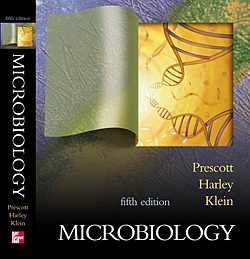 |  Microbiology, 5/e Lansing M Prescott,
Augustana College
Donald A Klein,
Colorado State University
John P Harley,
Eastern Kentucky University
Procaryotic Cell Structure and Function
Chapter ObjectivesAfter reading this
chapter you should be able to:
- identify major procaryotic cell structures in a drawing or photomicrograph
- describe the various sizes, shapes, and cellular arrangements exhibited by
procaryotes
- describe the bacterial plasma membrane and the limited internal membrane structures
found in procaryotes
- describe the appearance, composition, and function of the various internal
structures found in procaryotic organisms (such as inclusion bodies, ribosomes,
and the nucleoid)
- compare the structure of gram-positive and gram-negative bacterial cell walls
and explain how the differences between the two contribute to their Gram reaction
- describe external structures such as capsules, fimbriae and flagelladiagram and describe the various arrangements of bacterial flagella
- describe how bacteria use their locomotive ability to swim toward chemical
attractants and away from chemical repellents
- describe the production of the bacterial endospore and how it enables endospore-forming
bacteria to survive harsh environmental conditions and renew growth when the
environment becomes conducive to growth
|
|



 2002 McGraw-Hill Higher Education
2002 McGraw-Hill Higher Education